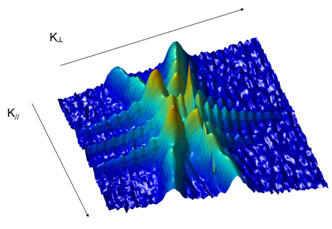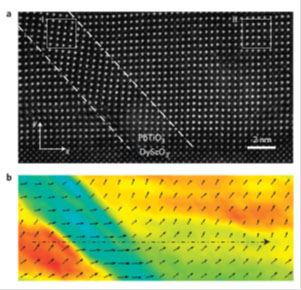Published in Nature Materials: Ultra-thin piezoelectrics for energy harvesting
Piezoelectric materials can transform mechanical energy into electrical energy and vice versa. Because of that they are used in a multitude of everyday applications from gas lighters to inkjet printers and from ultrasound generators in medical applications (echography devices, blood sensors, lithotripters) to vibration dampers (in cars, skis, helicopter blade).
However, piezoelectric materials have the potential to play an even greater role in society by harvesting the energy that is wasted ubiquitously as vibrations (from cars, house appliances, industrial machine) and transforming it into electricity. But in order to fulfil our dream of paving roads, railways and homes with piezoelectrics, these materials have to be made lighter, thinner and less toxic than the ones available today (which contain heavy chemical elements). An important step into this direction has been achieved by a team led by Beatriz Noheda (Zernike Institute for Advanced Materials) and in collaboration with the Mesa+ Institute of the University of Twente, the CIN2-Barcelona and the CEMES-CNRS Institutes in Toulouse and Zaragoza. The results have been published in Nature Materials.
Flexoelectricity
The researches have shown that ultra-thin films (with thickness of about 100 atomic layers) of piezoelectric materials deposited under carefully designed conditions, self-organize and flex at the nanometer scale in periodic fashion. This produces huge strain gradients (large differences in the distances between atoms) in such a way that a new mechanism to produce piezoelectricity can take place (so-called flexoelectricity). This greatly increases the materials response at these small thicknesses. Moreover, this novel way of producing piezoelectricity is less dependent on the chemical composition and will allow non-toxic and more readily available materials to be investigated for piezoelectric energy harvesting application.
Prof. Beatriz Noheda is Associate Professor of Functional Nanomaterials and Rosalind Franklin Fellow. In 2004 she received a NWO Vidi-grant.
Reference: Flexoelectric rotation of polarization in ferroelectric thin films, G. Catalan, A. Lubk, A. H. G. Vlooswijk, E. Snoeck, C. Magen, A. Janssens, G. Rispens, G. Rijnders, D. H. A. Blank and B. Noheda. Nature Materials.
DOI: http://dx.doi.org/10.1038/NMAT3141


| Last modified: | 24 August 2021 09.21 a.m. |
More news
-
23 April 2024
Nine MSCA Doctoral Network grants for FSE researchers
Nine researchers of the Faculty of Science and Engineering have received a Horizon Europe Marie Sklodowska Curie Doctoral Network grant.
-
22 April 2024
Charissa Roossien secures JTF subsidy to develop Health Tracker
Dr. Charissa Roossien (ENTEG) has successfully secured a Just Transition Fund (JTF) subsidy of 1.8 million euros to develop a Health Tracker for reliable respiratory and metabolic analysis.
-
16 April 2024
UG signs Barcelona Declaration on Open Research Information
In a significant stride toward advancing responsible research assessment and open science, the University of Groningen has officially signed the Barcelona Declaration on Open Research Information.
